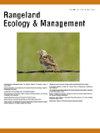基于agent的草地生态管理模型研究
IF 2.4
3区 环境科学与生态学
Q2 ECOLOGY
引用次数: 0
摘要
牧场管理需要在适合目标景观的尺度上解决复杂和动态的社会生态挑战和机遇。我们将地理空间和气候数据结合在一个基于智能体的系统动力学模型中,以模拟时间和空间可扩展的牧场人-环境-动物-饲料关系。建模高度可变的放牧系统元素需要适应性和数学真实感。基于代理的建模使得测试真实场景的替代方法成为可能,而无需承担与工作操作的实际实验相关的风险。我们的基于主体的模型,牧场生态管理,或ECo-Range,允许管理者通过设置影响模拟结果的环境条件和管理决策来模拟放牧情景。从这个意义上说,ECo-Range不仅是科学探究的产物,而且是用于协作发现的工具,因为它阐明了环境条件、管理决策以及模拟景观的生态和牲畜结果之间的关系。生态范围探索放牧管理的复杂性,包括而不是排除牧场社会生态系统固有的变异性和异质性。我们首先介绍ECo-Range,解释该模型与仿真建模和牧场管理领域的相关性。然后,我们提出了一个关于Colorado Front Range的案例研究,作为概念的证明,以测试ECo-Range作为一种学习工具的效用、有效性和适用性,以探索与政府拥有的景观相关的场景,这些场景需要对放牧进行管理。本文章由计算机程序翻译,如有差异,请以英文原文为准。
Agent-Based Modeling as a Tool for Ecological Comanagement of Grazing Lands
Rangeland management necessitates addressing complex and dynamic social-ecological challenges and opportunities at scales appropriate to target landscapes. We combine geospatial and climate data in an agent-based system dynamics model to simulate temporally and spatially scalable rangeland human-environment-animal-forage relationships. Modeling highly variable grazing system elements requires both adaptability and mathematical realism. Agent-based modeling makes it possible to test alternative approaches to real-world scenarios without taking risks associated with actual experimentation on working operations. Our agent-based model, Ecological Comanagement of Rangelands, or ECo-Range, allows managers to simulate cattle grazing scenarios by setting environmental conditions and management decisions that affect simulation outcomes. In this sense, ECo-Range is not just a product of scientific inquiry, but a tool to be used for collaborative discovery, as it illuminates relationships among environmental conditions, management decisions, and ecological and livestock outcomes for modeled landscapes. ECo-Range explores the complexities of grazing management, embracing rather than excluding variability and heterogeneity inherent in rangeland social-ecological systems. We first present ECo-Range, explaining the model's relevance to the fields of simulation modeling and rangeland management. We then present a case study on the Colorado Front Range as proof of concept to test the utility, validity, and applicability of ECo-Range as a learning tool to explore scenarios related to government-owned landscapes that necessitate comanagement approaches to cattle grazing.
求助全文
通过发布文献求助,成功后即可免费获取论文全文。
去求助
来源期刊

Rangeland Ecology & Management
农林科学-环境科学
CiteScore
4.60
自引率
13.00%
发文量
87
审稿时长
12-24 weeks
期刊介绍:
Rangeland Ecology & Management publishes all topics-including ecology, management, socioeconomic and policy-pertaining to global rangelands. The journal''s mission is to inform academics, ecosystem managers and policy makers of science-based information to promote sound rangeland stewardship. Author submissions are published in five manuscript categories: original research papers, high-profile forum topics, concept syntheses, as well as research and technical notes.
Rangelands represent approximately 50% of the Earth''s land area and provision multiple ecosystem services for large human populations. This expansive and diverse land area functions as coupled human-ecological systems. Knowledge of both social and biophysical system components and their interactions represent the foundation for informed rangeland stewardship. Rangeland Ecology & Management uniquely integrates information from multiple system components to address current and pending challenges confronting global rangelands.
 求助内容:
求助内容: 应助结果提醒方式:
应助结果提醒方式:


